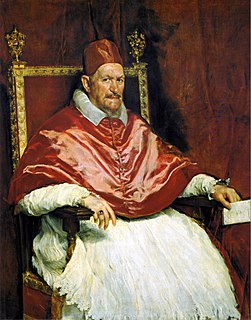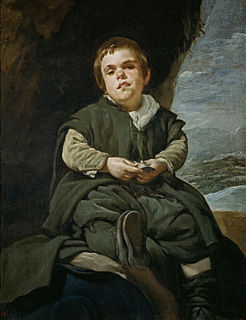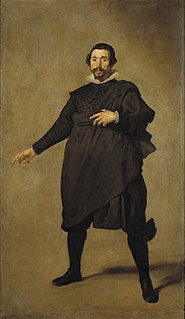 W
WPrince Balthasar Charles With a Dwarf is a 1631 portrait by Diego Velázquez of Balthasar Charles, Prince of Asturias and a court dwarf. It is now in the Museum of Fine Arts in Boston. It is the first of several portraits Velázquez painted of the young prince.
 W
WPortrait of the Infante Don Carlos is a 1626/27 oil painting of Don Carlos of Spain, produced by Diego Velázquez as one of the first paintings he produced during his stay in Madrid. It is now in the Prado.
 W
WDon Juan Mateos is an oil on canvas painting widely attributed to Diego Velázquez created circa 1632–3.
 W
WDoña Antonia de Ipeñarrieta y Galdós and Her Son Don Luis is a 1634 portrait by Diego Velázquez, now in the Prado Museum. Doña Antonia and her son Luis are shown standing, captured in an elegant melancholy. The woman uses the chair to support herself, to emphasize her social status in the Court, where she had the right to sit. According to different studies of the canvas, it is believed that the child's figure could have been added afterwards.
 W
WPortrait of Don Luis de Góngora is a 1622 painting in oils of the poet Luis de Góngora by Diego Velázquez. It is influenced by Caravaggio, especially in its chiaroscuro, and also applies lessons Velazquez had learned in Italy, such as the rich palette as used by Titian. It is now in the Museum of Fine Arts, Boston. The portrait was commissioned with the assistance of Velázquez's teacher, Francisco Pacheco.
 W
WPortrait of Pope Innocent X is an oil on canvas portrait by the Spanish painter Diego Velázquez, executed during a trip to Italy around 1650. Many artists and art critics consider it the finest portrait ever created. It is housed in the Galleria Doria Pamphilj in Rome. A smaller version is in the Metropolitan Museum of Art in New York, and a study is on display at Apsley House in London. The painting is noted for its realism, in that it is an unflinching portrait of a highly intelligent, shrewd but aging man. He is dressed in linen vestments, and the quality of the work is evident in the rich reds of his upper clothing, head-dress, and the hanging curtains.
 W
WThe Jester Barbarroja is an oil on canvas portrait by Diego Velázquez of Cristóbal de Castañeda y Pernia, nicknamed Barbarroja in his role as a jester at the court of Philip IV of Spain from 1633 to 1649. The painting is now in the Museo del Prado. It was in the Palacio del Buen Retiro in Madrid in 1701 and from 1816 to 1827 it was in the Real Academia de Bellas Artes de San Fernando.
 W
WThe Jester Calabacillas is a 1626-1632 oil on canvas painting by Diego Velázquez, now in the Cleveland Museum of Art. Its attribution is based on stylistic similarities to other works by the artist - for example, José López-Rey sees similarities in the treatment of the face in this work and that of Bacchus in The Triumph of Bacchus. Its subject is thought to be the jester Juan Calebasse, also painted by the artist in a work now in Madrid and a now-lost work entitled "calebasses in a turban", the latter recorded in 1642 and 1655 inventories of Diego Felipez de Guzmán's collection.
 W
WThe Jester Don Diego de Acedo is one of a series of portraits of jesters at the court of Philip IV of Spain by Diego Velázquez. Its subject is the dwarf Don Diego de Acedo, known as "el Primo". The 1645 oil painting is now in the Prado Museum. The work measures 106 cm high and 83 cm wide.
 W
WThe Jester Named Don John of Austria is a portrait by Velázquez, now in the Museo del Prado in Madrid. Its subject was a jester or bufón at the court of Philip IV of Spain from 1624 to 1654 who appeared in court comedies in front of important court figures. The subject's real name is unknown, but he came to be nicknamed after John of Austria, the son of Charles V, well known for his victory at Lepanto. He is shown dressed in a general's cloak and black doublet, is surrounded by abandoned helmets, armour and weapons, and with a fragment of a battle-scene of Lepanto in the background.
 W
WThe Lady with a Fan is a major oil painting by the Spanish court painter Diego Velázquez. It depicts a woman wearing a black lace veil on her head and a dark dress with a low-cut bodice. On the basis of its place in Velázquez's stylistic development, the portrait is thought to have been painted between 1638 and 1639. It is now in the Wallace Collection in London.
 W
WPortrait of Francisco Lezcano or The "Niño de Vallecas" is the 1645 portrait by Diego Velázquez of Francisco Lezcano, also known as Lezcanillo or el Vizcaíno, a jester at the court of Philip IV of Spain. It has been in the Prado since 1819.
 W
WInfanta Margarita Teresa in a Blue Dress is one of the best-known portraits by Spanish painter Diego Velázquez. Executed in oil on canvas, it measures 127 cm high by 107 cm wide and was one of Velázquez's last paintings, produced in 1659, a year before his death. It shows Margaret Theresa of Spain who also appears in the artist's Las Meninas. Currently, the painting is in the Kunsthistorisches Museum.
 W
WInfanta Margarita Teresa in a Pink Dress is a 1660 oil on canvas portrait of Margaret Theresa of Spain by the Spanish painter Diego Velázquez, though his identification as its author is not considered secure. It is now in the Prado Museum in Madrid.
 W
WThe Portrait of Maria Anna is a 1630 portrait of Maria Anna of Spain by Diego Velázquez. It is now in the Prado.
 W
WThe infanta Maria Theresa of Spain or The infanta Maria Theresa aged 14 is a 1653 portrait by Diego Velázquez of Maria Theresa of Spain, then about thirteen years. It has been cut down at the top and bottom and is now in the Kunsthistorisches Museum in Vienna.
 W
WPortrait of Mariana of Austria is a 1652–1653 oil-on-canvas painting by Diego Velázquez, the leading artist of the Spanish Golden Age, existing in a number of versions. Its subject, Doña Mariana, was the daughter of Emperor Ferdinand III and Maria Anna of Spain. She was nineteen years old when the painting was completed. Although described as vivacious and fun-loving in life, she is given an unhappy expression in Velázquez's portrait. The portrait is painted in shades of black and red, and her face is heavily made up. Her right hand rests on the back of a chair, and she holds a lace handkerchief in her left hand. Her bodice is decorated with jewellery, including a gold necklace, bracelets and a large gold brooch. A clock rests on scarlet drapery behind her, signifying her status and discernment.
 W
WThe Portrait of Juan Martínez Montañés is an unfinished 1636 portrait of the sculptor Juan Martínez Montañés by Diego Velázquez. It is now in the collection of the Prado museum in Madrid.
 W
WThe Needlewoman is an oil-on-canvas painting by Diego Velázquez, painted between 1635 and 1643. It is housed in the National Gallery of Art in Washington, D.C.
 W
WThe Portrait of Count-Duke de Olivares is a painting by Spanish artist Diego Velázquez, finished in 1635. It is housed in the Hermitage Museum of St. Petersburg.
 W
WGaspar de Guzmán, Count-Duke of Olivares, on Horseback is an oil on canvas painting by Spanish painter Diego Velázquez, made around the year 1636. It has been in the Museo del Prado in Madrid since its inauguration in 1819.
 W
WThe Portrait of the Count-Duke of Olivares is a 1624 portrait by Diego Velázquez, the most celebrated painter of the Spanish Golden Age. It is housed in the São Paulo Museum of Art in São Paulo, Brazil.
 W
WPortrait of Don Pedro de Barberana y Aparregui is an oil on canvas painting attributed to Velázquez and painted around 1631–1633. It has been in the Kimbell Art Museum in Fort Worth, Texas since 1981.
 W
WThe Equestrian Portrait of Philip III is a portrait of Philip III of Spain on horseback by Diego Velázquez. It was painted in 1634/35, some years after the subject's death, as part of a series of paintings of the royal family. Intended to be displayed in the Hall of Realms, originally a wing of the Buen Retiro Palace in Madrid, it is now in the Prado Museum.
 W
WThe Portrait of Philip IV or Philip IV in Brown and Silver is a portrait of Philip IV of Spain painted by Diego Velázquez. It is sometimes known as Silver Philip and is now in the National Gallery in London. It was the main portrait of Philip painted by Velázquez in the 1630s, used as the model for many workshop versions.
 W
WThe Portrait of Prince Philip Prospero is a 1659 portrait of Philip Prospero, Prince of Asturias by Diego Velázquez. It is now in the Kunsthistorisches Museum in Vienna.
 W
WThe Portrait of Sebastián de Morra is a painting by Diego Velázquez of Sebastian de Morra, a court dwarf and jester at the court of Philip IV of Spain. It was painted around 1644 and is now in the Prado in Madrid. Not much is documented about De Morra's life, other than the fact that he was brought to Spain by Phillip IV in 1643 and served the court for three years before his death in 1649. It wasn't until Velázquez became a court painter that he showed dwarfs with a warmer and naturalistic style compared to previous paintings. De Morra looks directly at the viewer, motionless, making no hand gestures, leading one critic to suggest that the painting represents a denunciation of the court's treatment of de Morra and other dwarfs. However, recently discovered inventories and previous documents relating to De Morra reveal that it could be known by a different name, El Primo.
 W
WPortrait of Pablo de Valladolid is a portrait painted around 1635 by Diego Velázquez of Pablo or "Pablillos" de Valladolid (1587–1648), a jester and actor at Philip IV's court from 1632 until his death. It is now in the Museo del Prado, to which it was moved in 1827.